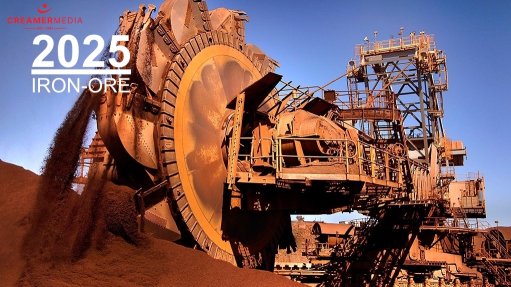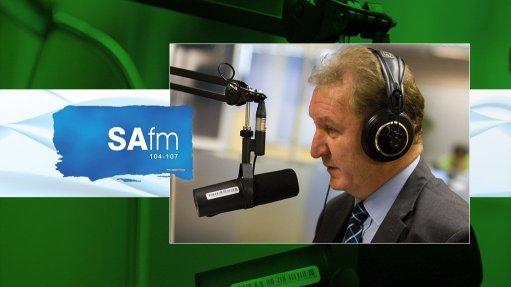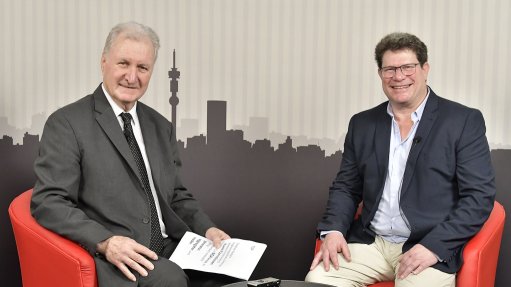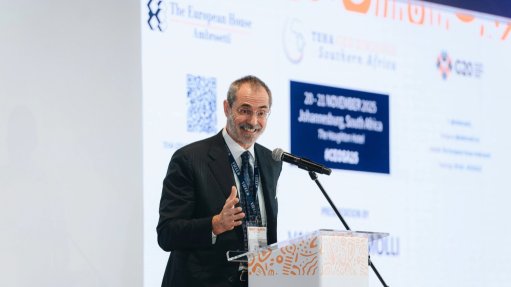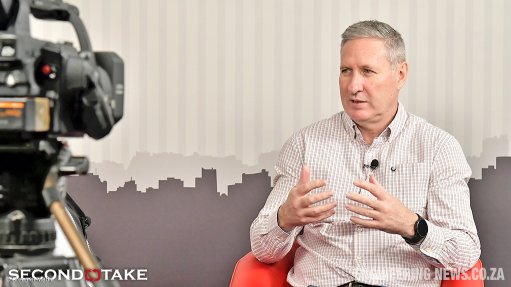Demand for platinum as an investment product is 'extremely strong'

World Platinum's Edward Sterck interviewed by Mining Weekly's Martin Creamer. Video: Darlene Creamer.
JOHANNESBURG (miningweekly.com) – The demand for platinum as an investment product is currently “extremely strong”.
“We’re seeing Chinese consumers who are looking for hard assets that are also liquid. With the increase in the gold price, investors are looking for alternatives and platinum naturally fits into that narrative,” World Platinum Investment Council research director Edward Sterck told Mining Weekly in a Zoom video interview, following the publication of the Platinum Quarterly Report for the Second Quarter of 2025, as well as an updated full-year 2025 forecast. (Also watch attached Creamer Media video.)
“What's really interesting is where we're seeing the strongest growth in platinum investment demand is in the smaller bar sizes and in coins, which is a clear indicator of broad-based demand.
“We're not talking about high net worth investors here, we're talking about the average consumer, the kind of retail-type consumer whose seeing a value opportunity in platinum,” Sterck pointed out, at a time when the platinum market is forecast to see its third consecutive annual deficit in 2025, which has been brought about by a combination of constrained supply juxtaposed with demand that is proving to be more robust than anticipated.
If you exclude Covid – so 2020, when output was impacted by Covid restrictions plus the outage at the then Anglo American Platinum and now Valterra ACP smelter in Rustenburg – 2025 is the lowest mine supply year since 2003.
Confronting the stronger-than-anticipated automotive demand for platinum, an inflection point for jewellery demand in China, and the “extremely strong” demand for platinum as an investment product, a nigh one-million-ounce 2025 deficit is on the way.
“If you look at forecast mine supply for this year, it's roughly seven-million ounces. If you look at forecast demand, it's roughly 7.9-million ounces, so regardless what happens as we go through to next year, we've still got that big supply/demand disconnect,” Sterck reported.
Discarded as being “pretty de minimis” is the 2% drop in automotive demand and described as “really just economics” is platinum’s looming five-year mine supply low: “The pricing just isn't adequate to sustain or increase supply going forward . . . our forecast for this year, and going forward for the next few years, is for ongoing and sustained deficits.”
Mining Weekly: What’s behind the recovery of platinum jewellery demand and how sustainable is it?
Sterck: There’s been a lot of focus when it comes to jewellery. Since 2014, we've had roughly 3.5% CAGR growth in demand for platinum jewellery from the world at large and what appears to be a fairly significant inflection point and quite substantial growth in China. The thing I should probably emphasise with regards to that growth potential in China is it's being led to a degree by the wholesalers and the retailers who are trying to compensate for a big decline in consumer demand for gold jewellery by offering something else, and that really means platinum, because China's not a big silver market to the same degree that Europe and North America are, so the wholesalers are trying to push that platinum jewellery into the market, which will result in a pretty significant year-on-year increase in terms of true consumer demand, but we don't have the data yet. I'd probably look towards the second week of October, which is Golden Week, and quite an important week in terms of retail sales for jewellery in China, to see confirmation of that really translating from the wholesaler efforts into true consumer buying.
How much of China’s investment demand is structural, and how much is being driven by current market conditions?
In contrast to the kind of slightly cautious message I just imparted regarding jewellery, the investment demand is very much a real thing.
How do you see platinum’s role in automotive sector evolving?
If you look ahead to 2026 and beyond, we continue to forecast a slower pace of drivetrain electrification than I think other market commentators and so we do see a higher-for-longer automotive picture in terms of demand for PGMs as a whole.
Why is industrial demand expected to contract?
If you look at industrial demand and, yes, we are expecting contraction this year, that's really very much a glass story. We've had five years of pretty significant capacity expansions in the glass sector, very much driven by China again. It's a story we've seen in some other sectors, where China's trying to take market share from other countries, and that's playing out in glass. We're seeing that with the fact that there's a very large liquid crystal display production facility in Japan that closed in the first quarter. Typically, from the majority of industrial end uses, platinum is not actually consumed by those industrial activities. It's just used to facilitate the production of, in this case, glass or alternatively as a catalyst to facilitate the production of different petroleum products. It's when new production facilities need to be populated with the platinum required to operate those facilities that you see a big demand drive for platinum. We've had five years of pretty significant expansion in terms of glass production facilities, and we're just seeing that naturally lead to a small downturn this year. Regarding the medium-term outlook, I would say that after this perhaps slight pause in terms of industrial output for glass in particular, we would probably see that return to growth in the course of 2026, 2027. Ultimately, glass fibre is going to be quite a big driving factor behind that and a lot of the driving factors behind glass fibre demand are things like renewable electricity generation, particularly wind. Whilst the US perhaps might be taking a slightly different journey going forwards to what was previously expected, the rest of the world is going to continue to commission more photovoltaic production generating capacity and wind and so on, so I think we’ll see that demand continue.
Platinum prices have reached a ten-year high this year, making it the best-performing commodity in 2025 so far. What do you think is driving the rally, and do you expect this price rally to continue?
To address the second part of your question first, you know that we can't give price forecasts, but I would say that the price rally hasn't eased tension in the market. If you look at the typical market indicators as to how freely available metal is, you can see that we've still got high lease rates, we've still got strong backwardation in the London ATC market, which suggests that even with the price increase, there's still an overall shortage of metal available, at least the prompt market. Addressing the first part of your question, what's behind this, ultimately we're in our third year of significant platinum market deficits. In a way, I’ll turn the question around and say, why didn't the price move higher earlier than this, and what we've seen has been that whilst the market's been in deficit, there’s been enough metal available from above-ground stocks to balance the market, at least on a short term basis, and we've just reached the point where that metal availability has declined until you need to see higher prices to unlock metal supply from other sources. We have seen some profit-taking from ETFs, for example, that have helped provide some metals to the market, we have seen some metal flow out of exchange stocks in the US but those have since started to rebuild again. But ultimately, we just haven't seen pricing move to a level where that's going to unlock enough metal from alternative sources of supply to keep the market balanced over the medium to longer term.
Above-ground stocks are forecast to decline by over 20% in 2025. How important is this in shaping price dynamics and investor sentiment?
I think those above-ground stocks are going to prove ultimately critical to keeping the market in balance. Fundamentally, if you look at supply from a price elasticity perspective, mine supply over the short to medium term is typically quite price inelastic when it comes to the PGM market. Recycling supply is slightly more elastic, so we’re expecting an increase of recycling supply this year. But fundamentally, there's a limit to how much recycling can increase, so I think overall, the price elasticity of total supply is still pretty limited, and so above-ground stocks have to continue to be the balancing factor.
Shanghai Platinum Week had record attendance this year. How significant is China to the platinum market and PGM demand?
As is the case in many other commodities, China is the biggest single-end market for PGMs and for platinum specifically. China continues to be very important. It's also worth noting that in contrast to some other metals, such as, for example, the rare earths, China does not have a significant geological endowment in terms of PGM deposits and so it's very reliant upon imports. If you look at the market as a whole, 70% of PGMs come from South Africa and so that kind of flow of metals from South Africa to the world at large and then ultimately to China, is something that's very important. Ensuring that they've got adequate reserves in the form of investment products and jewellery is something that there's a high degree of focus on and so we’re seeing that build-up of reserves there, I guess, as a form of domestic insurance against the potential for supply disruption in the future.
Market indicators point to tightness, with high lease rates and backwardation. What does this tell us about current market conditions, and how might this play out in the second half of the year?
As already touched on, it just shows that there is an overall shortage of metal in the spot market, and so that allows for lenders to charge more for lending out metal. It is also the factor behind the backwardation we're seeing in the ATC market. How is that going to play out through the rest of the year? Fundamentally, to ease those conditions you need increased supply. Where's that going to come from? If we look at mine supply, the first quarter of the year in particular was very negatively impacted by flooding in South Africa. On a broader basis, we also saw restructuring of North American operations and Nornickel in Russia struggled with integrating alternative mine equipment versus their previous Western suppliers. So, it would certainly be fair to say that we did see probably more constrained mine supply in the first half of the year than we're likely to see in the second half. There is a certain degree of calendar play out here, where typically you see bigger output in the fourth quarter, so strong seasonality overall in mine supply, and that's just being accentuated this year by the challenges that we saw in the first quarter, so I would expect the supply situation to ease a little bit as we go in towards 2026, but overall, if you look at forecast mine supply for this year, it's roughly seven-million ounces. If you look at forecast demand, it's roughly 7.9-million ounces, so regardless what happens as we go through to next year, we've still got that big supply/demand disconnect.
What can be done to ease platinum’s market tightness?
I'm not quite sure what the answer to that is. It's very hard to see a scenario where we would see a step change in terms of supply. There is some supply elasticity in terms of recycling, but I can't really see a massive step change in terms of mine supply over the near to medium term. Our forecast for this year, and going forwards for the next few years, is for ongoing and sustained deficits.
ABOVE-GROUND STOCKS
The projected 2025 deficit is expected to lower above-ground platinum stocks to 2 978 000 oz, covering four-and-a-half months of global platinum demand.
Article Enquiry
Email Article
Save Article
Feedback
To advertise email advertising@creamermedia.co.za or click here
Comments
Press Office
Announcements
What's On
Subscribe to improve your user experience...
Option 1 (equivalent of R125 a month):
Receive a weekly copy of Creamer Media's Engineering News & Mining Weekly magazine
(print copy for those in South Africa and e-magazine for those outside of South Africa)
Receive daily email newsletters
Access to full search results
Access archive of magazine back copies
Access to Projects in Progress
Access to ONE Research Report of your choice in PDF format
Option 2 (equivalent of R375 a month):
All benefits from Option 1
PLUS
Access to Creamer Media's Research Channel Africa for ALL Research Reports, in PDF format, on various industrial and mining sectors
including Electricity; Water; Energy Transition; Hydrogen; Roads, Rail and Ports; Coal; Gold; Platinum; Battery Metals; etc.
Already a subscriber?
Forgotten your password?
Receive weekly copy of Creamer Media's Engineering News & Mining Weekly magazine (print copy for those in South Africa and e-magazine for those outside of South Africa)
➕
Recieve daily email newsletters
➕
Access to full search results
➕
Access archive of magazine back copies
➕
Access to Projects in Progress
➕
Access to ONE Research Report of your choice in PDF format
RESEARCH CHANNEL AFRICA
R4500 (equivalent of R375 a month)
SUBSCRIBEAll benefits from Option 1
➕
Access to Creamer Media's Research Channel Africa for ALL Research Reports on various industrial and mining sectors, in PDF format, including on:
Electricity
➕
Water
➕
Energy Transition
➕
Hydrogen
➕
Roads, Rail and Ports
➕
Coal
➕
Gold
➕
Platinum
➕
Battery Metals
➕
etc.
Receive all benefits from Option 1 or Option 2 delivered to numerous people at your company
➕
Multiple User names and Passwords for simultaneous log-ins
➕
Intranet integration access to all in your organisation





